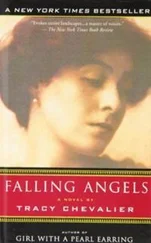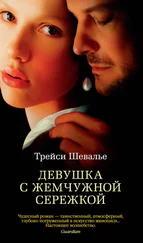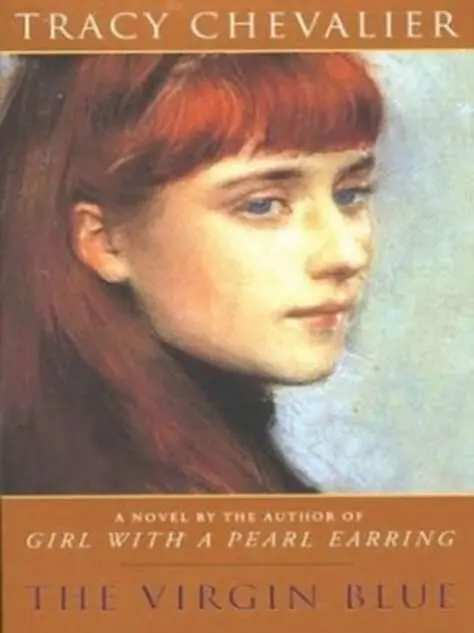
Tracy Chevalier
The Virgin Blue
© 1997
As yellow is always accompanied with light, so it may be said that blue still brings a principle of darkness with it. This colour has a peculiar and almost indescribable effect on the eye. As a hue it is powerful, but it is on the negative side, and in its highest purity is, as it were, a stimulating negation. Its appearance, then, is a kind of contradiction between excitement and repose.
Goethe, Theory of Colours
Translated by Charles Lock Eastlake
She was called Isabelle, and when she was a small girl her hair changed colour in the time it takes a bird to call to its mate.
That summer the Duc de l'Aigle brought a statue of the Virgin and Child and a pot of paint back from Paris for the niche over the church door. A feast was held in the village the day the statue was installed. Isabelle sat at the bottom of a ladder watching Jean Tournier paint the niche a deep blue the colour of the clear evening sky. As he finished, the sun appeared from behind a wall of clouds and lit up the blue so brightly that Isabelle clasped her hands behind her neck and squeezed her elbows against her chest. When its rays reached her, they touched her hair with a halo of copper that remained even when the sun had gone. From that day she was called La Rousse after the Virgin Mary.
The nickname lost its affection when Monsieur Marcel arrived in the village a few years later, hands stained with tannin and words borrowed from Calvin. In his first sermon, in woods out of sight of the village priest, he told them that the Virgin was barring their way to the Truth.
– La Rousse has been defiled by the statues, the candles, the trinkets. She is contaminated! he proclaimed. She stands between you and God!
The villagers turned to stare at Isabelle. She clutched her mother's arm.
How can he know? she thought. Only Maman knows.
Her mother would not have told him that Isabelle had begun to bleed that day and now had a rough cloth tied between her legs and a pillow of pain in her stomach. Les fleurs , her mother had called it, special flowers from God, a gift she was to keep quiet about because it set her apart. She looked up at her mother, who was frowning at Monsieur Marcel and had opened her mouth as if to speak. Isabelle squeezed her arm and Maman shut her mouth into a tight line.
Afterwards she walked back between her mother and her sister Marie, their twin brothers following more slowly. The other village children lagged behind them at first, whispering. Eventually, bold with curiosity, a boy ran up and grabbed a handful of Isabelle's hair.
– Did you hear him, La Rousse? You're dirty! he shouted.
Isabelle shrieked. Petit Henri and Gérard jumped to defend her, pleased to be useful at last.
The next day Isabelle began wearing a headcloth, every chestnut strand wound out of sight, long before other girls her age.
By the time Isabelle was fourteen two cypress trees were growing in a sunny patch near the house. Each time, Petit Henri and Gérard made the trip all the way to Barre-les-Cévennes, a two-day walk, to find one.
The first tree was Marie's. She grew so big all the village women said she must be carrying twins; but Maman's probing fingers felt only one head, though a large one. Maman worried about the size of the head.
– Would that it were twins, she muttered to Isabelle. Then it would be easier.
When the time came Maman sent all the men away: husband, father, brothers. It was a bitterly cold night, a strong wind blowing snow into drifts against the house, the stone walls, the clumps of dead rye. The men were slow to leave the fire until they heard Marie's first scream: strong men, accustomed to the sounds of slaughtered pigs, the human tone drove them away quickly.
Isabelle had helped her mother at birthings before, but always in the presence of other women visiting to sing and tell stories. Now the cold kept them away and she and Maman were alone. She stared at her sister, immobile beneath a huge belly, shivering and sweating and screaming. Her mother's face was tight and anxious; she said little.
Throughout the night Isabelle held Marie's hand, squeezed it during contractions, and wiped her forehead with a damp cloth. She prayed for her, silently appealing to the Virgin and to Saint Margaret to protect her sister, all the while feeling guilty: Monsieur Marcel had told them the Virgin and all the saints were powerless and should not be called upon. None of his words comforted her now. Only the old prayers made sense.
– The head is too big, Maman pronounced finally. We have to cut.
– Non, Maman , Marie and Isabelle whispered in unison. Marie's eyes were wild and dilated. In desperation she began to push again, weeping and gasping. Isabelle heard the sound of flesh tearing; Marie shrieked before going limp and grey. The head appeared in a river of blood, black and misshapen, and when Maman pulled the baby out it was already dead, the cord tight around its neck. It was a girl.
The men returned when they saw the fire, smoke from the bloody straw billowing high into the morning air.
They buried mother and child in a sunny spot where Marie had liked to sit when it was warm. The cypress tree was planted over her heart.
The blood left a faint trace on the floor that no amount of sweeping or scrubbing could erase.
The second tree was planted the following summer.
It was twilight, the hour of wolves, not the time for women to be walking on their own. Maman and Isabelle had been at a birthing at Felgérolles. Mother and baby had both lived, breaking a long string of deaths that had begun with Marie and her baby. This evening they had lingered, making the mother and child comfortable, listening to the other women singing and chatting, so that the sun had sunk behind Mont Lozère by the time Maman waved away cautions and invitations to stay the night and they started home.
The wolf lay across the path as if waiting for them. They stopped, set down their sacks, crossed themselves. The wolf did not move. They watched it for a moment, then Maman picked up her sack and took a step toward it. The wolf stood and Isabelle could see even in the dark that it was thin, its grey pelt mangy. Its eyes glowed yellow as if a candle were lit behind them, and it moved in an awkward, off-balance lope. Only when it was so close that Maman could almost reach out and touch the greasy fur did Isabelle see the foam around its mouth and understand. Everyone had seen animals struck with the madness: dogs running aimlessly, foam flecking their mouths, a new meanness in their eyes, their barks muffled. They avoided water; the surest protection from them, besides an axe, was a brimming bucket. Maman and Isabelle had nothing with them but herbs, linen and a knife.
As it leapt Maman raised her arm instinctively, saving twenty days of her life but wishing afterwards that she had let it rip out her throat quickly and mercifully. When it fell back, when the blood was streaking down Maman's arm, the wolf looked at Isabelle briefly and disappeared into the dark without a sound.
While Maman told her husband and sons about the wolf with candles in its eyes, Isabelle cleaned the bite with water boiled with shepherd's purse and laid cobwebs over it before binding the arm with soft wool. Maman refused to sit still, insisted on picking her plums, working in the kitchen garden, continuing as if she had not seen the truth shining in the wolf's eyes. After a day her forearm had swelled to the same size as her upper arm, and the area around the wound went black. Isabelle made an omelette, added rosemary and sage, and mouthed a silent prayer over it. When she brought it to her mother she began to cry. Maman took the bowl from her and ate steadily, her eyes on Isabelle, tasting death in the sage, until the omelette was gone.
Читать дальше
Конец ознакомительного отрывка
Купить книгу


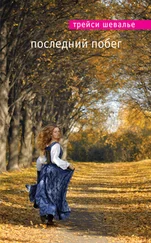
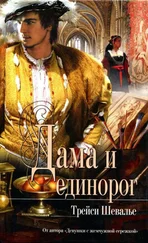

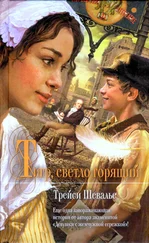

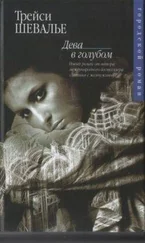
![Трейси Шевалье - Тонкая нить [Литрес]](/books/386177/trejsi-shevale-tonkaya-nit-litres-thumb.webp)

